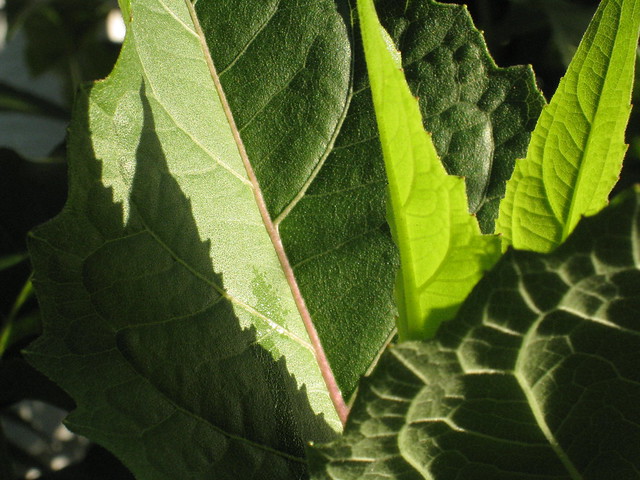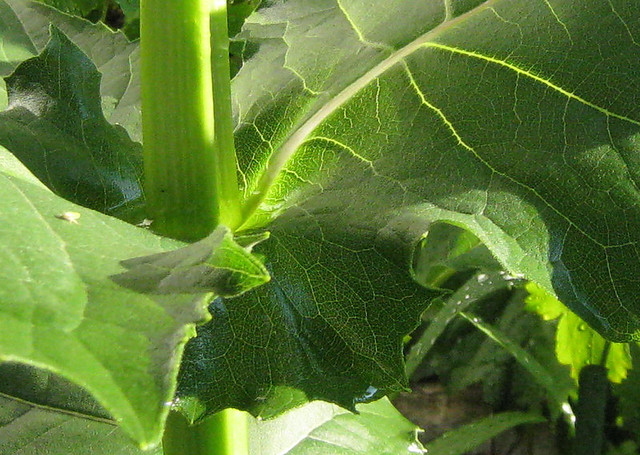 |
| Monarch Butterfly on Cup Plant bloom AMcC |
One of my favorite native plants is Cup Plant, Silphium perfoliatum. My first experience with it was in Hidden Meadow at Girl Scout Camp Cedarledge. My friend Sandy, whose position was “Nature Specialist,” showed me how the large opposite leaves wrap the square stem to form a cup. It had been hot and dry, but when she tipped the tall stalk, water dripped out. Pretty cool! Much later, I read about a couple who got rid of their bird feeders and planted a wildlife garden. I wish I could remember the title of the book, but I do remember that next to their windows, they planted cup plant so that they could enjoy watching the birds use the “natural birdbath.” I resolved to do the same when I got my own home.
Cup plant is a true garden personality. I do sometimes see chickadees and other birds land on the large leaf and dip into the “cup” for a drink. Perhaps they also capture insects in the water. The leaf is pointed, with a jagged edge and rough as sand paper. The stem is thick, smooth, straight, and square, giving it another common name, “Carpenter’s Weed” (Kurz, Ozark Wildflowers, 121). If you were to design a garden plant that breaks all the rules of garden plant developers and hybridizers, you’d come up with Cup Plant. There’s nothing dainty about it. Now you know why I like it!
 |
| Cup Plant leaves in June AMcC |
By early August, many of my plants are 8 feet tall. Plants that don’t receive as much light and water are smaller. Towering plants with large leaves filled with rainwater sometimes tip over during a storm. If you have a good spot for Cup Plants, plan on staking them up in early summer, and use a really stout stake.
Cup plant blooms are always in demand with bees of all sorts, especially bumblebees. It’s worth remembering that native bees such as bumble bees are much less likely to sting than honeybees, but if you’re concerned, don’t plant it near the door or walkway. I welcome bees and other pollinators, but I found out my mail carrier didn’t. This perennial does spread from the root, so I could afford to thin the herd. Once I removed a plant or two and staked the others up away from the box, he started delivering my junk mail again.
 |
| Leaves form a cup as they enclose the stem. AMcC |
The blooms of Cup Plant are a bit more than 3 inches across. Like other members of the Aster family, they provide the perfect landing platform for butterflies. When they’re in bloom, I frequently see 4 different butterfly species in the yard at a time. Today’s Cup Plant list: Monarch, Painted Lady, Fiery Skipper, and Checkered White butterfly. Bumblebees, carpenter bees (known as “long-tongued” bees) and butterflies are the most important pollinators for Cup Plant. When it goes to seed, American Goldfinches, House Finches, and (on rare occasions) Pine Siskins will visit.
Butterflies and Moths of Missouri, by J Richard and Joan E. Heizman (1987) mentions that the caterpillar of a moth, Eucosma giganteana (no common name), bores into the root of Silphium. With its wings closed, E. giganteana looks a lot like a small bird dropping—a great strategy for avoiding hungry birds. With a little research, I kicked up this story by P. J. Johnson: In South Dakota, Cup plant is being studied as a possible source of renewable energy! It’s possible that Cup Plant will be used to produce biodiesel fuel or plastics. If it is to be grown as a biomass crop however, scientists need to know about the possible impact of E. giganteana on the crop, especially since Cup Plant is its one and only host or larval food plant. Their studies found the larva in the flower heads, leaves and stems, but not in the root. I did find a caterpillar on one of my plants, but it looked nothing like the larva pictured in Johnson’s article. Apparently, E. giganteana is very uncommon, but I’m still going to examine bird droppings a little more closely.
I was all gaga about my cup plant, too...and then I found out that it is incredibly invasive here. It's a prairie plant, not native to our mountains here, and where folks have planted it, it has taken over, especially in riparian zones. So, along with several other favorites that turned out to be invasive, I pulled mine out last year. However, I was walking past the garden the other day and noticed a suspicious-looking plant. Could it be it has come back? I'll have to go out and take a closer look - I may need to pull it out again.
ReplyDeleteHere in Missouri, Cup Plant is a bit aggressive, but not invasive. As you point out, it's important to know which species are native to your area and which ones present a threat to native plants. Thanks for the info! Here's a small collection of links about invasive plants: http://delicious.com/naturenut2/invasive
ReplyDelete